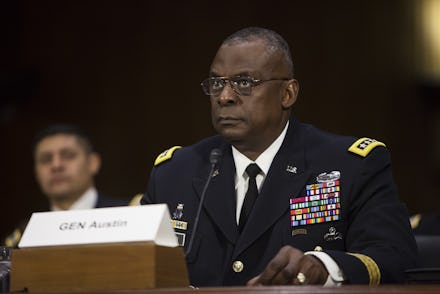Here's what the secretary of defense really does

Since taking office, President Joe Biden has begun quickly assembling his Cabinet. The people he chooses will help advise him on a variety of matters, including foreign affairs, military efforts, and more. Last month, Lloyd J. Austin III became the United States's first Black secretary of defense following his Senate confirmation hearing. And while you can generally guess what the secretary of defense does based on the name, there's a bit more to the position than what meets the eye.
Obviously, the secretary of defense heads up the U.S. Department of Defense, which describes itself as the nation's "oldest and largest government agency, tracing its roots back to pre-Revolutionary times." In the most basic sense, the secretary of defense advises the president on military and international security policy. The Department of Defense is housed in the famously five-sided Pentagon building in Arlington, Virginia.
The secretary of defense sits alongside other Cabinet positions, including the vice president and the heads of 14 other executive departments, like the secretary of state, and a few other positions, like White House chief of staff. Here are a few more interesting facts about the position.
The product of World War II-era confusion
While the Department of Defense traces its roots back to pre-Revolutionary times, the agency itself isn't that old. Before the Department of Defense was created, each branch of the military operated pretty independently. This caused some issues during World War II. See, while both the Army and the Navy fought together in the war under unified commanders, their departments still reported individually to the president, which led to unnecessary confusion. In response, Congress passed the National Security Act of 1947 to create the National Military Establishment.
Under that law, the War Department and Navy Department became a single entity under the direction of the newly created secretary of defense. The National Security Act also created the United States Air Force, also under the purview of the secretary of defense. The Department of Defense would gain its current name when the National Security Act was amended in 1949.
The boss of the nation's largest employer
The U.S. pours a ton of money into the Department of Defense. For this fiscal year, former President Donald Trump sent a proposal to Congress that requested $740.5 billion for national security, and $705.4 billion of that went to the Department of Defense alone.
Per the Department of Defense website, that money goes toward a variety of things, like equipment and training for military personnel. But of course, the Pentagon has people to pay, too. In fact, the Department of Defense is not only the nation's largest employer — it's also the largest employer in the world.
Overall, the Department of Defense employs about 3 million people. According to The Balance Careers, as of June 2020 this included about 1.3 million active duty personnel, 801,000 reservists, 761,000 civilians, and 224,000 people stationed overseas.
The sixth in the presidential line of succession
If anything was to happen to the president, the vice president would be first in line for the presidency. After, the order goes: the speaker of the House, the president pro tempore of the Senate, the secretary of state, the secretary of the treasury, and then the secretary of defense.
Being in sixth in line makes it extremely unlikely that any secretary of defense would become president due to the line of succession. Still, it's always worth mentioning.